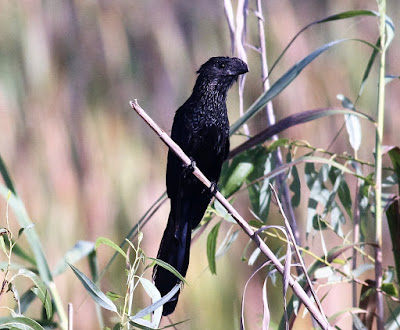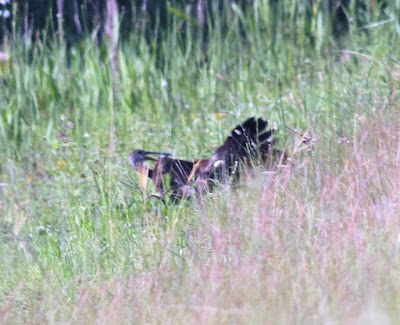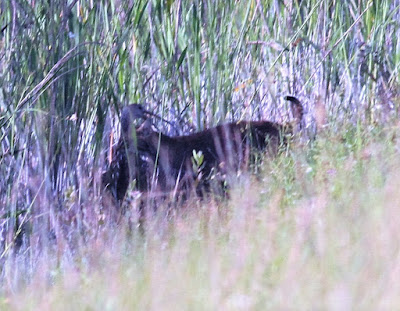The last stop on our road trip was Savannah, Georgia. The campsite was at the mouth of the Savannah River, close to the beach. In the campsite itself a group of 4 Mississippi Kites were regular at one of the dead trees. Up to 4 Common Nighthawks also displayed over the camp every evening. At the nearby shopping strip were a small group of 3 Grey Kingbirds.
On the beach itself the main birds were the large number of Brown Pelicans commuting between the colony on an island close to the mouth of the river and the offshore feeding areas. Both Royal Terns and Sandwich Terns were also regular.
Grey Kingbird.
Mississippi Kite. A group of up to 4 were in the campsite at most times, with other birds being seen overhead both in Savannah itself, and the surrounding area.
Cooper's Hawk. Being harassed by a group of American Crows on the beach
Common Nighthawk. One of at least 4 present each evening.
Brown Pelican
Thursday, July 28, 2016
Saturday, July 23, 2016
Florida Scrub-Jay, Jonathon Dickinson SP - 23rd July
My last birding day in Florida was dedicated to tracking down the only true endemic in Florida, Florida Scrub-Jay. Said to be easily found in the early morning in the right habitat, coastal scrub. Jonathon Dickinson State Park opened at 8:00, and I was on the first bird by about 10 past!
I found at least 8 in about an hour of looking, almost all of which were sporting colour rings.
Some birds were very confiding, obviously quite used to the presence of people.
The park has plenty of dead trees scattered around in the scrub, these make perfect sentry posts for the Scrub-Jays.
I found at least 8 in about an hour of looking, almost all of which were sporting colour rings.
Some birds were very confiding, obviously quite used to the presence of people.
The park has plenty of dead trees scattered around in the scrub, these make perfect sentry posts for the Scrub-Jays.
Friday, July 22, 2016
Wakodahatchee Wetlands, Boca Raton - 22nd July
In the same general area as Loxahatchee, Wakodahatchee Wetlands is another great spot. The boardwalk here gets a lot of use from local residents so the birds are well adapted to people, great for photography. Best bird was the pair of American Purple Gallinule with a chick. Good views of several species at nests including Wood Stork and Anhinga.
One oddity was a Grey-headed Swamphen wandering about a little further away from the boardwalk.
American Purple Gallinule, smashing bird!
The youngster is pretty nice too, interesting bill pattern already.
This Grey-headed Swamphen is completely out of place, one of Florida's many, many escapees.
Wood Stork
Glossy Ibis
Double-crested Cormorant
Anhinga with young
Cattle Egret feeding young
Juvenile Cattle Egret
Boat-tailed Grackle
One oddity was a Grey-headed Swamphen wandering about a little further away from the boardwalk.
American Purple Gallinule, smashing bird!
The youngster is pretty nice too, interesting bill pattern already.
This Grey-headed Swamphen is completely out of place, one of Florida's many, many escapees.
Wood Stork
Glossy Ibis
Double-crested Cormorant
Anhinga with young
Cattle Egret feeding young
Juvenile Cattle Egret
Boat-tailed Grackle
Loxahatchee National Wildlife Refuge, Boca Raton - 22nd July
Apart from birds I bumped into a Nine-banded Armadillo, and had an amazing sighting of a hunting Bobcat, see this page for the details.
Limpkin, very confiding birds indeed...
...even the very young ones were unfazed by my presence.
Mottled Duck. A bit boring, but what can you do?
Black-bellied Whistling Duck
White Ibis
Smooth-billed Ani
Common Moorhen with a chick
Alligator. Only a couple visible, but surely many more present.
Bobcat hunting Limpkin, Loxahatchee NWR - 22nd July
An amazing morning's birding at Loxahatchee National Wildlife Refuge near Boca Raton, with the cherry on the cake being an extraordinary encounter between a Bobcat and a Limpkin.
The first sight of the Bobcat was on the raised road/ levee between the main part of the swamp and the managed pools. It was just strolling along in the morning light, having a poo, and just doing it's thing. It didn't like the look of me (100 yards away) so ducked down off the raised road into the long grass. I searched for a while, but gave up and carried on.
20 minutes or so later I was walking back down the road, when the Bobcat stepped out in front of me again, this time about 80 yards ahead. It was looking away from me so didn't notice me, but it did spot this Limpkin....
...immediately it froze, shrank down into itself and slinked off into the grass. The Limpkin wandered out into the middle of the road, quite oblivious of the cat. There were a couple of nearby Red-winged Blackbirds that started calling so I knew the hunt was on, so I waited. And waited. About 10 minutes passed with not much going on, and I was about to give up.....
...then Bang! Contact! The cat moved so fast I hardly saw it and only really captured the action when they were halfway down the opposite bank....
...The Limpkin was alive all the way down, but had no chance....
....the Bobcat headed straight into the reedbed....
...Limpkin screeching the whole way. I briefly approached the area they had disappeared, but there was nothing to see, lots to hear though, with squawks and snarls from both parties.
The first sight of the Bobcat was on the raised road/ levee between the main part of the swamp and the managed pools. It was just strolling along in the morning light, having a poo, and just doing it's thing. It didn't like the look of me (100 yards away) so ducked down off the raised road into the long grass. I searched for a while, but gave up and carried on.
20 minutes or so later I was walking back down the road, when the Bobcat stepped out in front of me again, this time about 80 yards ahead. It was looking away from me so didn't notice me, but it did spot this Limpkin....
...immediately it froze, shrank down into itself and slinked off into the grass. The Limpkin wandered out into the middle of the road, quite oblivious of the cat. There were a couple of nearby Red-winged Blackbirds that started calling so I knew the hunt was on, so I waited. And waited. About 10 minutes passed with not much going on, and I was about to give up.....
...then Bang! Contact! The cat moved so fast I hardly saw it and only really captured the action when they were halfway down the opposite bank....
...The Limpkin was alive all the way down, but had no chance....
....the Bobcat headed straight into the reedbed....
...Limpkin screeching the whole way. I briefly approached the area they had disappeared, but there was nothing to see, lots to hear though, with squawks and snarls from both parties.
Friday, July 15, 2016
Merritt Island State Park - 15th to 16th July
Final stop before getting to Fort Lauderdale was Merritt Island. The home of both Cape Canaveral, and a major wetland it seemed tailor-made for us. Once again Fiona and the boys did the tourist thing at NASA, while I paddled around in the swamp. Brilliant!
Best bird was undoubtedly the half dozen or so Reddish Egrets on show, prancing around like ballet dancers, very striking birds. Also new were Loggerhead Shrike and Mottled Duck. Other birds included Roseate Spoonbill, all the usual herons, Short-billed Dowitchers and Black-necked Stilts.
Mammals were represented by a dolphin spp., as well as a marvelous family of Manatees. Very fat, and very, very slow, they are just great.
Roseate Spoonbill
White Ibis
Reddish Egrets
Green Heron
Tricoloured Heron
Snowy Egret and juvenile Tricoloured Heron
Manatee
Best bird was undoubtedly the half dozen or so Reddish Egrets on show, prancing around like ballet dancers, very striking birds. Also new were Loggerhead Shrike and Mottled Duck. Other birds included Roseate Spoonbill, all the usual herons, Short-billed Dowitchers and Black-necked Stilts.
Mammals were represented by a dolphin spp., as well as a marvelous family of Manatees. Very fat, and very, very slow, they are just great.
Roseate Spoonbill
White Ibis
Reddish Egrets
Green Heron
Tricoloured Heron
Snowy Egret and juvenile Tricoloured Heron
Manatee
Thursday, July 14, 2016
Little Talbot Island State Park - 12th to 14th July
Next stop was at Little Talbot State Park, in the extreme north of Florida. The campsite was a short walk from the beach, right next to a swamp. Perfect!
The best birding was at a spot called Spoonbill Pond on Big Talbot Island. Obviously there were Roseate Spoonbill there, along with a large flock of American White Pelican, some White Ibis, and lots of various heron spp. A Wood Stork put in an appearance on the second day.
The beach was interesting, but with far fewer species. Best birds were the 3 Sandwich Terns mixed in with the Royal Terns. Other species included 3 Brown Pelicans and several Willets.
The woodland around the park was supposed to hold a few good birds, but they were fairly thin on the ground. A Yellow-throated Warbler was nice, as was a roost of a hundred or so Purple Martins. Common Ground-Doves were in the grassy areas, a pair of Painted Buntings hung out at the feeder near the main gate, and Great Crested Flycatcher hawked over our tent.
A lone Wood Stork visited the Spoonbill Pond
American White Pelican
Royal Tern
Sandwich Tern
Willet
Yellow-throated Warbler
Purple Martin
The best birding was at a spot called Spoonbill Pond on Big Talbot Island. Obviously there were Roseate Spoonbill there, along with a large flock of American White Pelican, some White Ibis, and lots of various heron spp. A Wood Stork put in an appearance on the second day.
The beach was interesting, but with far fewer species. Best birds were the 3 Sandwich Terns mixed in with the Royal Terns. Other species included 3 Brown Pelicans and several Willets.
The woodland around the park was supposed to hold a few good birds, but they were fairly thin on the ground. A Yellow-throated Warbler was nice, as was a roost of a hundred or so Purple Martins. Common Ground-Doves were in the grassy areas, a pair of Painted Buntings hung out at the feeder near the main gate, and Great Crested Flycatcher hawked over our tent.
A lone Wood Stork visited the Spoonbill Pond
American White Pelican
Royal Tern
Sandwich Tern
Willet
Yellow-throated Warbler
Purple Martin
Tuesday, July 12, 2016
Charleston - 10th to 12th July
The second stop on our big trip was the Great Smoky Mountains. Sadly a knackered ankle kept me bedridden for a couple of days, so no birds, and no photographs. Next up was Charleston. We decided on a plantation visit, and selected Magnolia Plantation on the Ashley River. Fiona & the boys did the house, while I focused on the swamp, an equitable arrangement. The swamp here hosts a sizeable heronry, mostly Great White Egret and Little Blue Heron, with Snowy Egret, Tricoloured Heron, Great Blue Heron, Green Heron, and Yellow-crowned Night Heron also present. Lots of Anhinga too, my first in North America.
Non-herons included flyovers by Mississippi Kite and Wood Stork, both new for me. Red-shouldered Hawk is the common raptor. More Carolina Chickadees in the woodland, and lots of Carolina Wrens too.
In Charleston itself the most interesting birds were the flocks of White Ibis that passed over every morning and evening.
Anhinga
Little Blue Heron...
...and a youngster. I watched the adult diligently trying to teach three newly fledged juveniles how to fly. Hilarious.
Green Heron
Beneath the heronry the Alligators make wait for the chicks unfortunate enough to fall out of the nests
Brown Pelican, from the boat we took to visit Fort Sumter
More Alligators, this time at a wetland reserve south of Charleston
Non-herons included flyovers by Mississippi Kite and Wood Stork, both new for me. Red-shouldered Hawk is the common raptor. More Carolina Chickadees in the woodland, and lots of Carolina Wrens too.
In Charleston itself the most interesting birds were the flocks of White Ibis that passed over every morning and evening.
Anhinga
Little Blue Heron...
...and a youngster. I watched the adult diligently trying to teach three newly fledged juveniles how to fly. Hilarious.
Green Heron
Beneath the heronry the Alligators make wait for the chicks unfortunate enough to fall out of the nests
Brown Pelican, from the boat we took to visit Fort Sumter
More Alligators, this time at a wetland reserve south of Charleston
Subscribe to:
Posts (Atom)
























































